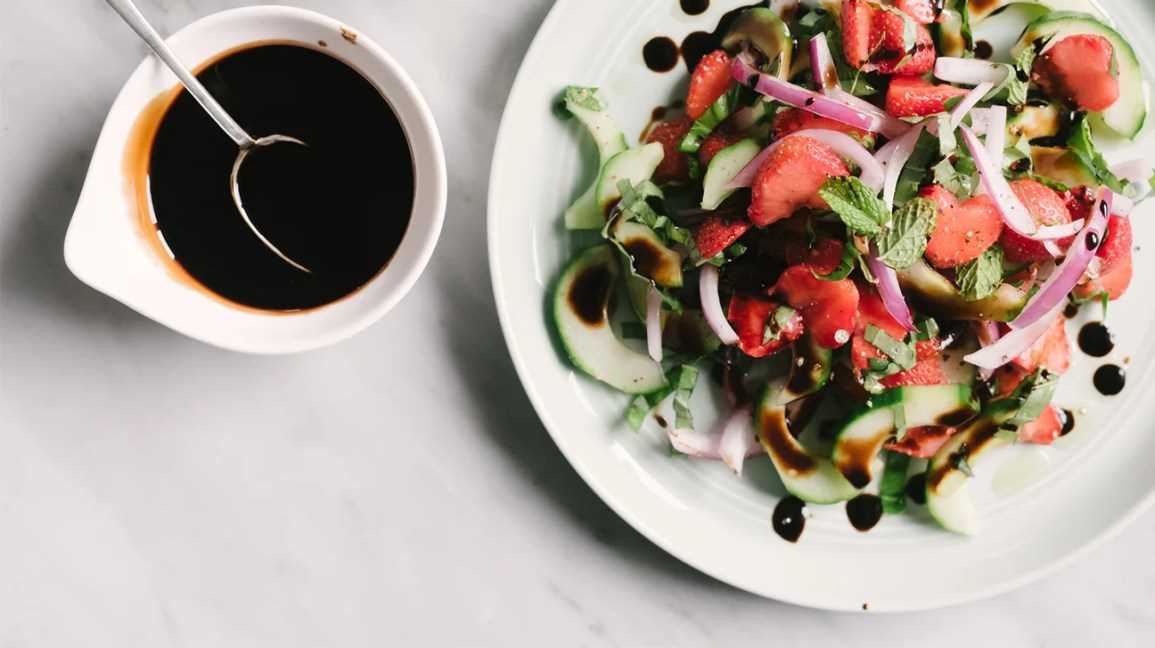

Using a dark, syrupy condiment in place of a more acidic variety can work, but it requires careful consideration. The flavor profile of the thicker liquid is sweeter and more complex than that of its counterpart. Adjusting the quantity is essential; start with a smaller amount and taste as you go to avoid overwhelming the dish.
When incorporating this alternative, balance is key. Dishes that benefit from a touch of sweetness, such as marinades for grilled meats or salad dressings, can be enhanced with this option. However, for recipes that rely on sharpness to cut through richness, the thicker replacement might not deliver the desired acidity. In such cases, adding a splash of lemon juice or a dash of a sharper condiment can help mimic the necessary tang.
Ultimately, experimentation is encouraged. Each dish is unique, and personal preferences play a significant role in achieving the right flavor. Consider the overall ingredients and the dish’s intended profile to determine how best to implement this substitution in your culinary creations.
Can I Substitute Balsamic for Red Wine Vinegar?

Using a dark, sweet condiment in place of a tangy, acidic option can alter the flavor profile significantly. If you decide to make this switch, be mindful of the following:
- Flavor Balance: The sweet notes of the darker liquid might overwhelm dishes that rely on sharpness. Consider reducing the amount used.
- Acidity Level: The acidity in the dark variety tends to be lower. To mimic the tartness, add a splash of lemon juice or a pinch of citric acid.
- Color Impact: The hue of your dish will change, which may not be suitable for all recipes. Keep this in mind for presentation.
For dressings or marinades, try blending with a bit of mustard or herbs to balance sweetness. Experimentation will yield the best results based on the specific dish you are preparing.
In sauces or reductions, remember that the richer taste can complement hearty meals but may clash with lighter fare. Adjust other ingredients accordingly to maintain harmony in the overall flavor.
Using a mixture of equal parts water and the darker variety can also help achieve a more neutral taste, allowing it to fit better into your culinary creations.
Flavor Profile Differences Between Balsamic and Red Wine Vinegar
The rich, sweet, and complex profile of the first option differs significantly from the sharper, more acidic notes of the latter. The former presents a velvety texture with pronounced sweetness, often resulting from a lengthy aging process in wooden barrels. This aging imparts deep flavors, reminiscent of figs and raisins, making it an excellent choice for drizzling over salads or finishing dishes.
In contrast, the latter offers a more straightforward acidity with fruity undertones that can brighten dishes without overwhelming them. It typically has a tangy bite, which enhances savory recipes, marinades, and reductions. This vinegar excels in balancing rich flavors, making it a staple in many Mediterranean cuisines.
When considering the differences, it’s clear that the sweetness and complexity of the first option can alter the overall flavor profile of a dish significantly. If a recipe calls for the second option, using the first may lead to a sweeter outcome, potentially overshadowing the intended flavors. Understanding these distinctions allows for better culinary decisions based on the desired taste and balance in your cooking.
Best Dishes to Use Balsamic Instead of Red Wine Vinegar
Using a rich, sweet version of the fermented grape product can elevate several dishes. Here are some recommendations for specific recipes where this alternative shines.
Salads
In salads, especially those featuring fruits or nuts, swapping in a sweeter version enhances the overall flavor. Consider a spinach salad with strawberries, feta, and walnuts. The sweetness complements the strawberries beautifully.
Marinades
When preparing marinades for meats, especially chicken or pork, the darker liquid adds depth. Combine it with olive oil, garlic, and herbs for a flavorful blend that tenderizes and infuses the proteins with a unique taste.
Glazes
A reduction creates a delicious glaze for roasted vegetables. Try drizzling it over Brussels sprouts or carrots before roasting to caramelize the natural sugars, enhancing their sweetness.
Dipping Sauces
For dipping sauces, mixing it with olive oil and fresh herbs provides a robust accompaniment for bread. The contrast of flavors makes it a delightful starter for any meal.
| Dish Type | Recommended Use |
|---|---|
| Salads | Enhances flavors in fruit and nut combinations |
| Marinades | Adds depth to meats, especially poultry and pork |
| Glazes | Creates a sweet caramelized coating on roasted vegetables |
| Dipping Sauces | Mixes well with olive oil and herbs for bread dipping |
These applications highlight the versatility of this alternative, bringing new flavors to classic dishes. Enjoy experimenting in your kitchen!
Adjusting Recipes When Changing Vinegars
When swapping one type of acidic liquid for another, start by reducing the amount used. If the original recipe calls for a specific quantity, use about three-quarters of that amount initially. Taste as you go, since the flavor profile differs significantly.
Consider the sweetness level. The alternative may have a richer sweetness, so balance it with additional salt or acidity to maintain the intended flavor. If a dish requires a sharp tang, you might need to incorporate a touch of lemon juice or a bit of another sour element.
Texture and Consistency
Keep in mind that the thickness can vary. If the alternative is thicker, thin it out with a bit of water or broth. This adjustment helps maintain the right consistency in dressings or marinades.
Cooking Techniques

Cooking methods can change the outcome as well. If using a sweeter liquid in a heated application, be cautious of burning, as it may caramelize faster. Adjust cooking times accordingly to prevent unwanted flavors.
Each adjustment requires tasting to get the balance just right, ensuring the dish remains enjoyable and flavorful. Experimentation is key, so don’t hesitate to make small changes until the desired flavor is achieved.
Health Benefits of Balsamic Vinegar Compared to Red Wine Vinegar
Incorporating this sweet and tangy liquid into your diet offers several health advantages over its counterpart. It is lower in calories and contains fewer sugars, making it a suitable choice for those monitoring their weight or blood sugar levels.
This condiment is rich in antioxidants, which can help combat oxidative stress in the body. Antioxidants play a vital role in reducing inflammation and promoting overall health. Additionally, the presence of polyphenols, particularly in traditional varieties, may support heart health by improving cholesterol levels and blood circulation.
Another notable benefit is its potential to aid digestion. The acidity can enhance the digestive process and may assist in balancing gut health. Furthermore, both types of vinegar have been linked to improved blood sugar control, but the unique compounds found in this syrupy version may exert a more pronounced effect due to its fermentation process.
When considering these benefits, it’s clear that choosing this option can contribute positively to a balanced diet. Always remember to enjoy it in moderation, as excessive consumption can lead to unwanted effects. For those looking to expand their culinary repertoire, try using it in a dish like how to cook abalone in shell to experience its unique flavor and health benefits.
When Not to Substitute: Situations to Avoid Using Balsamic Vinegar
Avoid using this sweet and syrupy condiment in recipes where a clean, acidic kick is paramount. For dishes that require a bright and tangy finish, such as vinaigrettes or marinades meant to enhance fresh vegetables or fish, the richness of balsamic can overwhelm the intended flavors.
Cooking Techniques to Consider
When braising or deglazing, the depth of flavor from a traditional red wine-based option is often necessary. The caramelized notes of balsamic can interfere with the desired outcome. In sauces that rely on a sharp, clear acidity to balance richness, this alternative may not provide the necessary contrast.
Specific Dishes to Avoid
For classic French dishes like coq au vin or beef bourguignon, the robust flavor profile of red wine is essential. The substitution can lead to an unrecognizable dish. Similarly, in pickling processes, the unique qualities of the original ingredient are lost when using a sweeter option.
FAQ:
Can balsamic vinegar be used as a substitute for red wine vinegar in recipes?
Balsamic vinegar can be used as a substitute for red wine vinegar, but there are some differences to consider. Balsamic vinegar is sweeter and has a thicker consistency compared to the more acidic and sharper flavor of red wine vinegar. If you’re using balsamic as a substitute, you may want to adjust the quantity or balance it with a bit of lemon juice or another acid to achieve a similar flavor profile.
What are the main flavor differences between balsamic vinegar and red wine vinegar?
The primary difference lies in their flavor profiles. Balsamic vinegar is rich, sweet, and complex, with a syrupy texture, often used in dressings or drizzled over dishes. On the other hand, red wine vinegar has a sharper, tangy taste that can enhance savory dishes. This contrast means that while they can be swapped in some recipes, the resulting taste may vary significantly.
How does the substitution affect the dish’s overall taste?
Substituting balsamic vinegar for red wine vinegar can alter the overall taste of the dish. The sweetness of balsamic can make a salad dressing or sauce taste different, possibly more mellow. In savory dishes, this substitution might result in a flavor that is less tangy and more rounded. It’s advisable to taste as you go and adjust other ingredients to maintain balance.
Are there any dishes where balsamic vinegar should not replace red wine vinegar?
Yes, there are specific dishes where using balsamic vinegar instead of red wine vinegar may not be ideal. For example, in recipes that rely on the sharp acidity of red wine vinegar, such as marinades for meats or certain vinaigrettes, balsamic may make the dish too sweet. Traditional recipes, especially in Mediterranean cuisine, often call for red wine vinegar to achieve a specific flavor balance that balsamic may not replicate.






